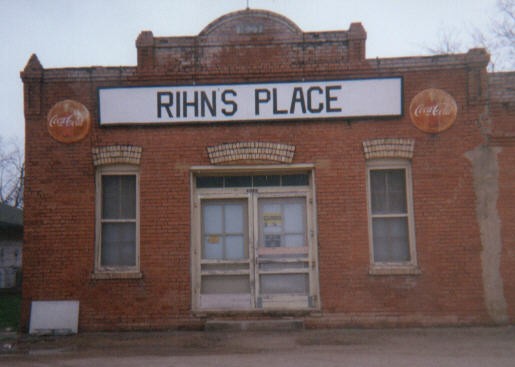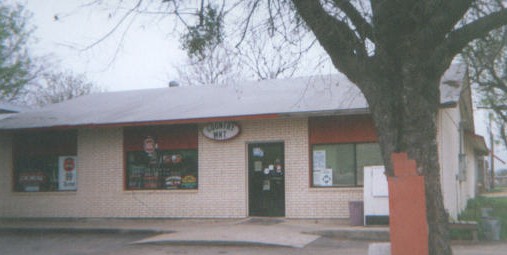

| Naomi Leija & Debra Morales | Spring 2001 |
| History 1302 | Hines |
ORIGINS:After generations of Indians inhabited the land, there came the Spanish and the French to visit present day LaCoste. The Spanish and French came through leaving behind their own names for all the lakes and rivers in the area. In about 1836, Santa Ana's army crossed the Medina River which runs alongside LaCoste, in the march to Bexar, where they had an important meeting with Bowie, Travis and Crockett at the Alamo.
"FOUNDING FATHERS":In 1881, the G.H. & S.A. Railroad were traveling west from San Antonio heading in the direction of El Paso. They felt that the area was just right to set up a railroad station. A wealthy businessman from San Antonio invested money in this undertaking and the town was named LaCoste, after Col. Jean B. LaCoste. It wasn't until May 22, 1898 that the post office decided to change its name to LaCoste. After the railroad was built, the town began to grow. Since LaCoste became a regular stop, general stores, houses, and saloons were built near the railraods. Soon after that a church and schools were built. There were two schools; one was for the whites and one for Mexicans.
ECONOMY: At first, most of the business that started in LaCoste was at the saloon where there was gambling and racing, but later on other businesses began to spring up. Eddieeelf Biediger said, "There was a drugstore, bank, two mercantile, feed stores, and hotels."
The LaCoste Ledger was founded by Francis Biediger's grandfather, Louis Biediger in August 1915, then L. Biedeger's son John. Rosalia Flores served as a midwife and knew of many roots that could be used for medicinal purposes. When her services could not be paid for with money, she accepted chicken and vegetables as payment. The Schmidt and Gross was built in 1907, and was sold in 1917 to the Famer's Union. One of the main economic problems LaCoste had was with water. Francis Biediger went on to say that, "We put in our own water system. Our own sewer system, which we didn't have before." Without this addition, LaCoste would not have continued to flourish. Some of the most prominent businessmen in town were, "Albert Palmer who has been the president of the LaCoste National Bank... and Eugene Keller who was the owner and operator of the John Deere implement."
LANDMARKS:Construction of Our Lady of Grace Catholic Church took place in January 1911 because many people had to travel some time to get to St. Louis Catholic Church in Castroville. People from the town of LaCoste, asked permission to build this church so they didn't have to travel so far. Some people feel that the completion of the church changed the town. It no longer headed in the direction of a gambling, party town, but to one that was more business oriented.
TORNADO:
May 5, 1958
"Yeah, I was in this building at that time. The only thing got damaged was that old school building over here. It sustained any damage, of any amount. It jumped up that time, it dissipated, and it went back down again on the farm property east of LaCoste, but after that it just dissipated," is what Francis Biediger recalled. The school suffered the most damage when the tornado touched down. It destroyed the second floor, but there was not much damage anywhere else.
MAKING A CONNECTION:
In the late 19th century LaCoste was founded because one of the main technological advances at the time. It was the result of the construction of new railroads that were built every day. A hotel was also built to accommodate the passengers that got off of the train and needed to stay for the night. Also, agriculture was a big part of their success. They irrigated their land using the water from Medina Lake, and grew crops such as corn and cotton. They were also able to put in their own sewer system. In connection with the continuing problem of racism, LaCoste kept their schools separate by having one white school and one school for Mexicans.
INTERVIEWS: After speaking with a couple that has lived in LaCoste for about 11 years now, they didn't have to much to say. Mr. and Mrs. Duncan live in LaCoste having moved from a busy city life. Mrs. Duncan said that, "Living in a small town is the best. You live life with no problems. We have those days when it just seems the joy will never end." "Quiet and peaceful is this town," said Mr. Duncan. The couple told me that, "You seem to enjoy life better when you're not in a big city."
THE STREETS OF LACOSTE:




FUTURE PROSPECTS:
LaCoste, Texas was founded in 1881 because of the railroad. It thrived on it's agriculture, the local businesses, and it even enjoyed a time when there was a local newspaper. There were several stores, people traveling through on their way to El Paso, gambling, drinking, and farming. As the years went by however, the local businesses moved away, and on to bigger and better places. Mr. and Mrs. Francis Biediger believe that one of the main problems today is growth. "Yeah, they're looking for growth but it's not going to grow. It's not on a major highway." There is not much hope for growth in these small Texas towns.

ANNOTATED BIBLIOGRAPHY:
Biediger, Cheryll Bennett and Alice Ray Sazman Boehme. Echoes of the
Past, Historical Collections of LaCoste, Northside, Spindletop, Pearson/Noonan,
Sauz, Idlewild, and Macdona. The LaCoste Garden Club, 1996.
"LACOSTE, TX." The Handbook of Texas Online.
Francis and Eddieeef Biediger, interview by Debra Morales. March 23, 2001.
Mr. and Mrs. Duncan, interview by Naomi Leija. March 2001.